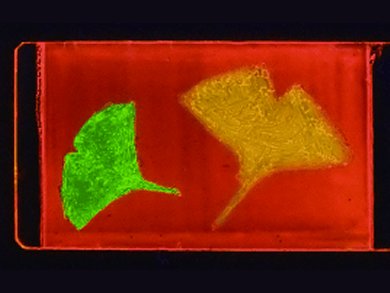Switching Between Three Colors
Luminescent materials that change their light-emitting properties in response to external stimuli could provide interesting new approaches for novel storage materials, sensors, security materials, and information displays. Typically, such materials can either be switched from “on” to “off” or between two different colors. It has not previously been possible to switch between three different stable colors with materials containing only a single luminescent substance. In the journal Angewandte Chemie, Takashi Kato and Yoshimitsu Sagara from the University of Tokyo, Japan, have now introduced a liquid-crystalline material that can be switched back and forth between three different colors by means of thermal and mechanical stimuli.
The new material consists of two dumbbell-shaped organic compounds—one small and one large, both consisting of a branched arrangement of aromatic six-membered rings. The large molecule contains an anthracene component as the luminescent group (luminophore). This mixture of molecules aggregates to form liquid crystals. Molecules in a liquid-crystalline state are partially ordered like in a crystal, but are mobile like in a liquid. Liquid crystals are most commonly found in liquid-crystal displays.
Rub to Change Color
The Japanese researchers prepared thin films of their special liquid crystals. Under UV light, these films glow red-orange. Mechanical shearing, such as rubbing, at 90 °C changes the arrangement of the liquid crystals—the rubbed areas now appear green. This new, green phase is stable between room temperature and 146 °C. This amazing film can do more: both the red-orange and green phases can be changed to a yellow one by rubbing at room temperature. Heating to 145 °C and subsequent cooling to room temperature changes the green and yellow back to red-orange.
If this luminescent mixture can be incorporated into materials such as structural polymers, the thermal and stress histories for the materials are easily detected by bright luminescence color changes. Knowledge of these histories is useful for the maintenance of the materials systems, which include coatings and plastics. In addition, artists may be interested in these materials because of the beauty of the luminescence colors and the ease of writing/erasing and stability of the generated images.

- Brightly Tricolored Mechanochromic Luminescence from a Single-Luminophore Liquid Crystal: Reversible Writing and Erasing of Images
Y. Sagara, T. Kato,
Angew. Chem. Int. Ed. 2011.
DOI: 10.1002/anie.201100914




